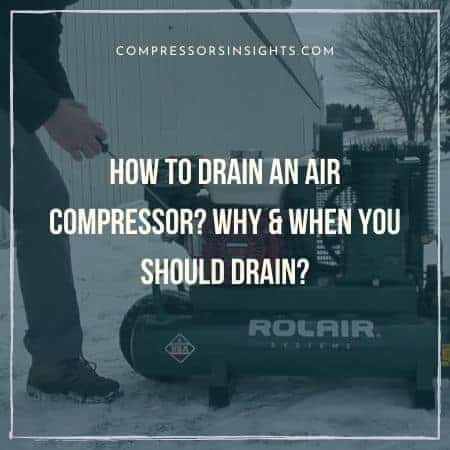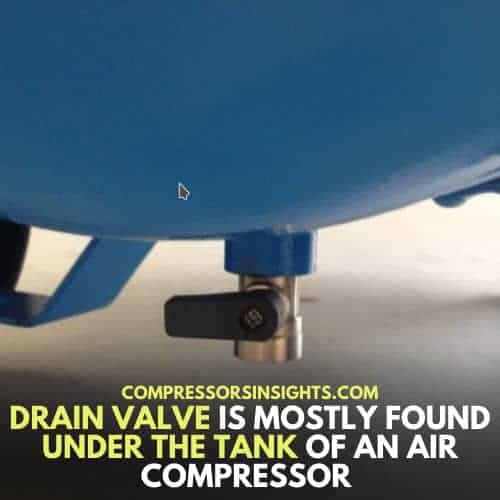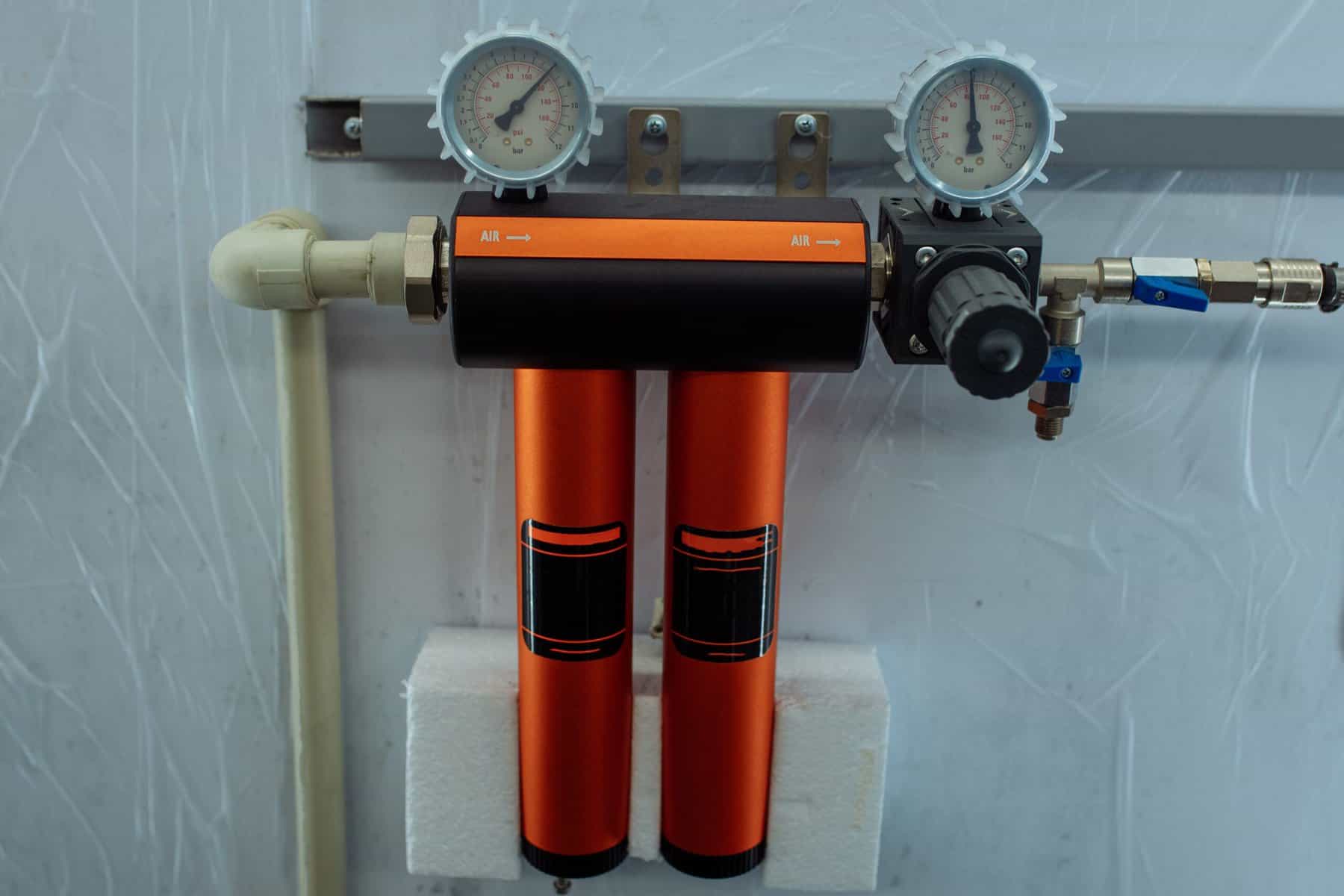How to Drain An Air Compressor? Why & When You Should Drain?
TheToolGeeks.com is a participant in the Amazon Services LLC Associates Program and other affiliate advertising programs. We may earn from qualifying purchases. (Learn More).
Air compressors have become an essential part of many people’s lives, especially technicians or engineers. You can also use it at home, office, or an industrial site. However, air compressor maintenance makes it go for a long time. In the maintenance process, one of the primary steps is draining.
The real problem is that not many people know how to drain an air compressor, the steps to drain the compressor are, and what can happen if you do not remove the moisture inside the compressor.
Draining is easy as you only need to open the valve, but there are a few precautions to take, which we will discuss in the article.

Why Drain Water or Air from Air Compressor?
Air Compressor Maintenance is the primary thing to keep the compressor working, increasing its lifespan. In maintenance, draining the moisturizer from the compressor is the most important and easiest step. Removing air from the air compressor makes it serve more.
How does Water get into the Air Compressor?
The air gets sucked into the air compressor to get compressed. When air is compressed, the temperature of the air increases and it becomes hot, which causes it to hold more water vapor. Since it cannot contain more or the same amount of water vapor when it is cold, the remaining or extra water leads to the air compressor.
The water vapor turns into water particles, and no drainage leads to a buildup. Water, air, and oil buildup in the air compressor tank can cause many issues. When you do not drain the moisturizer, the water over time gets into it because the air volume decreases.
What Will Happen If You Don’t Drain an Air Compressor?
The air compressor draining has some importance. If you do not drain the moisturizer from the air compressor, it can lead to many problems. Those issues are:
Rust
If the moisturizer remains in the air compressor, it can cause rusting. Water causes rust which can cause the structure of an air compressor to fall apart. And eventually, the weakness can lead to the malfunction of the compressor.
Chances of tank bursting
The moisturizer in the tank causes rusting, and over time rust causes the walls of the compressor to become thinner. As a result, the compressor will not last as long and may burst.
Air Volume Decreases
Air compressor maintenance is crucial, and one of the primary things is to drain the tank. When water accumulates in the compressor, it causes a decrease in air volume in the compressor’s tank. The decrease leads to not having the pressure when needed as it is filled with water.
Air Tools Compatibility issue
When you do not drain the compressor, the water inside the compressor can get into the air tools attached to the compressor, affecting the compressor’s efficiency.
Effects efficiency
Any accumulation, whether it is water, air, and oil buildup in the air compressor tank, will reduce the space and the amount of air in the compressor, and the pressure gauge reading will be affected. It will cause a reduction in the efficiency of the compressor.
Damage to Pneumatic tools
The buildup (Dirt and Moisture) in the compressor can block the airflow, and it can also get in the airways of the pneumatic tools of the compressor.
How to Drain an Air Compressor Tank?
Manual Draining Procedure
If you want to manually drain your air compressor tank, you should follow the steps mentioned below.
1. Locate the Air Compressor Drain Valve
Following particular steps is a part of the air compressor air tank draining procedure. Firstly, search for the drain valve, which is usually under the tank. In rare cases, it will be on the side of the tank. If the drain valve is on the side, you may need to tilt the compressor while draining.

2. Set Low PSI
Secondly, open the safety valve and release pressure to or below 10 PSI. This step is just before opening the drain valve.
The purpose of reducing pressure is to ensure the safety of a person who’s about to conduct the draining procedure.
3.Open the Drain Valve
In the first step, you’ve located the drain valve on the air compressor tank. It’s time to open the drain valve so that the moisture and compressed air may come out from the air compressor’s tank. Place the container or bucket under the drain valve.
Make sure to tilt the air compressor tank so that remaining moisture or oil buildup may drain from the air compressor tank.
To drain water, the side valve needs some air pressure. Start the compressor, let it build some pressure, and later turn it off. Open the valve again, and water will pour out.
4. Close the Drain Valve
Once the compressor is drained, close the drain valve. The advice is to use thread tape on the drain valve to ensure no leakage.
Automatic Air Compressor Drain
The automatic air drain in the compressor is convenient when you do not want to drain the compressor manually. It is an electronic automatic drain valve in which you set the frequency and the time duration. It works with a 12V.
All you need to do is screw out the manual one and screw in the electronic one if you want to drain your air compressor automatically.
Setting the Timer in an Automatic Drain Valve
Turning knobs cycles the draining device. You can adjust the timer for an hour or a day, and mostly it is best to do it once a day. By doing this, it will open the valve, drain the water, and will close it. It is self-cleaning too, and you will not face any clogging issues.
Some Precautions While draining an air Compressor
In the air compressor tank draining procedure, you should always keep some precautions in your mind. It will not only protect you but your compressor too.
- Make sure to turn off the compressor before draining it.
- Reduce the pressure to 10 PSI or 0.
- Pull the safety valve.
- Wear safety glasses before draining.
- Deflect air by shielding with one hand.
- You can tilt the compressor.
- Tight the calve, or use threading tape after draining.
- You can use soapy water to check leakages.
How often do you drain the air compressor tank?
The owners of air compressors mostly have this question in mind: whether they should drain their compressor and how often they should do it? The manufacturers of the compressors recommend draining the compressor daily.
The water in the tank’s button can cause rusting, and it leads to forcing you to buy a new one. Usually, you can do it manually, but if you feel you forget this often, buy an electronic drain valve, it will be helpful.
Should I Drain the Air Compressor After Every Use?
If you aren’t going to use the air compressor the next day, you need to drain it after each use. If you use an air compressor every day but forget to drain it, you may drain it after 2-3 days.
If you have to use an air compressor after 4-5 hours, then draining after every use is not recommended. Draining is recommended if you need to use the air compressor after a day or two.
Does Air Pressure in the Tank Help in the Draining Process?
Air pressure regulates the pressure in the compressor, and since it stores air in the tank, it is ideal for long-term air supply.
Cooling the air and removing the water from the compressor help in decreasing pulsations. Additionally, it reduces the stress on the compressor pump and increases its lifespan.
Conclusion
Air Compressor Maintenance makes the compressor work for a long time. Many people use air compressors at home but never pay attention to maintenance. In compressor maintenance, the easiest step is draining the compressor.
However, not many people know how to drain air compressors. To help out those people, we’ve highlighted some of the significant draining steps in this article.
Besides the air compressor tank draining procedure, you should always wear glasses, turn off the compressor, and set the compressor below 10 PSI.
Removing moisture from the air compressor prevents rusting, bursting, tools damage, or decreasing inefficiency. Make sure to drain the compressor every other day to make it work longer.
FAQ’s
How to blow out water lines with an air compressor?
If you want to blow the waterline with an air compressor, attach the hose using Teflon. Attach the hose to the water line and hook the adaptor to it. Make sure to turn off the faucet. Now attach the air compressor to the hose. However, do not put pressure on more than 50 pounds per square.
Should I keep Drain Open If I’m Storing An Air Compressor?
Keep the drain valve open since it helps remove moisture from the air compressor. If you are not going to use the air compressor for a while and want to store it, it will be best to keep it open. In addition to removing moisture from the air compressor, keeping the tank open also prevents corrosion.
Amazon and the Amazon logo are trademarks of Amazon.com, Inc, or its affiliates.

